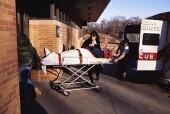
SATURDAY, Jan. 4, 2014 (HealthDay News) — New research suggests it may not make much difference to survival if victims of gunshots and stabbing injuries are transported to the emergency department in a police car or by emergency medical services (EMS).
The study sheds light on the “scoop and run” approach to such injuries, which emphasizes getting a patient to the hospital quickly, even in a police car, instead of making a higher priority of treating the patient on the way through emergency medical services.
“It is critically important to remember that our study focuses on a very specific type of patient with a specific disease process in a densely populated urban environment,” senior study author Dr. Brendan Carr, assistant professor of emergency medicine and biostatistics and epidemiology at the University of Pennsylvania School of Medicine, said in a university news release.
“We in no way are suggesting that patients with serious medical symptoms, such as chest pain or difficulty breathing, do anything but call 911 and await the highly trained EMS personnel who have the skill and equipment to deal with the situation and any potential problems,” Carr explained.
The study — published online Jan. 2 in Annals of Emergency Medicine — tracked more than 4,100 patients treated in emergency rooms in Philadelphia from 2003 through 2007. Almost 3,000 were transported by emergency medical services and more than 1,100 by police officers. More than three-quarters suffered gunshot wounds, while the others were stabbed.
Overall, 27 percent of the patients died, with the risk slightly higher than that for those transported by the police and slightly less for those who got an assist from emergency medical workers. But the difference seems related to the fact that the cops tend to transport patients with more severe wounds.
Gunshot patients with the most severe wounds were more likely to survive if police took them to the hospital. “There could be many factors contributing to this finding, such as the fact that police may have shorter response times to an event simply by virtue of how they patrol,” lead author Dr. Roger Band, assistant professor of emergency medicine at the Hospital of the University of Pennsylvania, said in the news release.
The Philadelphia police department’s policy calls for police personnel to transport people suffering from a serious penetrating wound, such as that from a gun or knife, to the nearest accredited trauma center. “Transportation will not be delayed to await the arrival of the Fire Department paramedics,” the policy states.
“This study is an examination of current prehospital practices with an eye toward improving patient care and is by no means intended as a criticism of the highly trained and dedicated professionals of the Philadelphia Fire Department who provide outstanding care under difficult circumstances,” said Band.
More information
The U.S. National Library of Medicine has details on traumatic injuries.
Copyright © 2025 HealthDay. All rights reserved.
